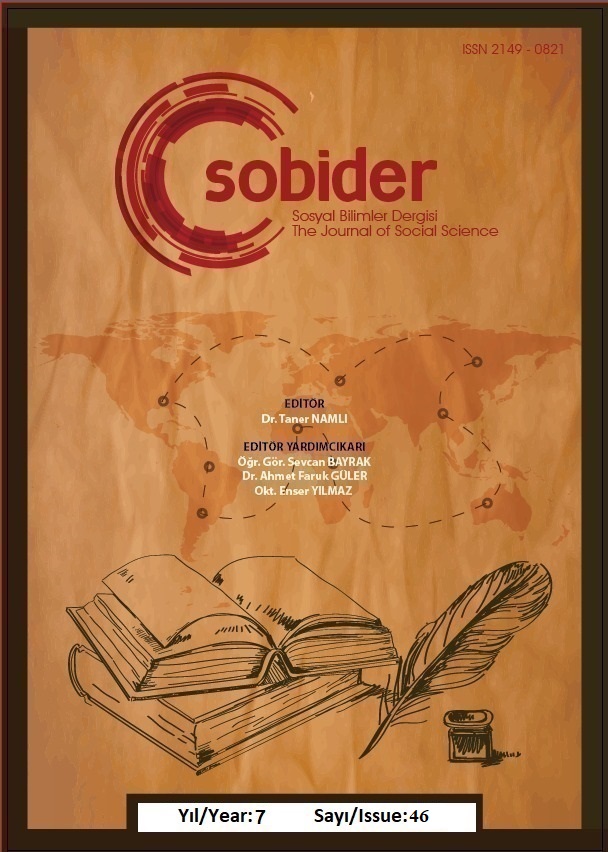EDEBİYATIN ÜRETİMİ VE YAYILIMINDA SÖYLENCE OLGUSU: BİR ŞİİRİN SÖYLENCELEŞMESİ VE TÜRKÇEYE ÇEVİRİSİ ÜZERİNE BİR İRDELEME
Author :
Abstract
Gerçek hayata seçenek bir gerçeklik oluşturan edebiyat, fantastik ögeleri kullanmaktadır. Fantastik ögelerin kullanım oranı edebiyat ürününün türüne göre değişiklik göstermektedir. İçine doğduğu toplumun ve kültürün bir üyesi olan edebiyatçı, eserinin inşasında kimi zaman söylenceyi bir malzeme gibi kullanmaktadır. Ancak bir söylence, kimi zaman da edebiyat yolu ile pekiştirilir, geniş kitlelere ulaşır. Bu anlamda söylence ile edebiyat arasındaki ilişki, bir etkileşim halini alır. Bu çalışmada kuramsal bağlamda söylence ile edebiyat arasındaki ilişki, ‘Lorelei’ örnek durumu ışığında irdelenmeye çalışılmıştır. Ren Nehri’nin söylencelerinden biri olan ‘Lorelei’ figürünün ilkin Clemens Brentano (1801) tarafından ele alınışı, söylencenin edebiyat eli ile şekillenmesine örnek oluşturmaktadır. Diğer yandan söylenceyi daha geniş kitlelere yayan, aynı adlı şiiri ile Heinrich Heine (1824) olmuştur. Edebiyatın yayılımına hizmet eden bir araç olarak çeviri etkinliği bağlamında bu çalışmada Heine’nin ‘Lorelei’ adlı şiiri Christiane Nord’un (1988) metin çözümleme modeline dayanılarak çözümlenmiş, şiirin Dora Güney ve Necati Cumalı tarafından Türkçeye yapılan çevirisi ile ilgili eleştirel değerlendirmelerde bulunulmuştur.
Keywords
Abstract
Literature, which creates an alternative reality to real life, uses fantastic elements. The usage rate of fantastic items varies according to the genre of literature product. Being a member of the society and culture in which he was born, the literary artist sometimes uses the legend as a material in the construction of his work. However, a myth is sometimes reinforced through literature and reaches large masses. In this sense, the relationship between legend and literature becomes an interaction. In this study, the relationship between legend and literature in the theoretical context is tried to be examined in the light of the example case of 'Lorelei'. One of the myths of the Rhine River, the figure of 'Lorelei', was first handled by Clemens Brentano (1801), and it is an example of how the legend is shaped by the hand of literature. On the other hand, it was Heinrich Heine (1824) with his poem of the same name that spread the myth to a wider audience. In the context of the translation activity as a tool that serves the spread of literature, in this study, Heine's poem 'Lorelei' was analyzed based on the text analysis model of Christiane Nord (1988), and critical evaluations were made about the translation of the poem into Turkish by Dora Güney and Necati Cumalı.
Keywords
- Nord (1988), and critical evaluations were made about the translation of the poem
- dolayısıyla gerçeklikle bağlantılarının tartışılabilir oluşudur. Benzer biçimde Karakurt’a (2011:
- olabilir. Efsanenin en önde gelen özelliği ona inanılmasıdır” (Alpaslan 1992: 32). Yani
- farkı onların gerçekliğe olan uzaklıklarına göre değerlendiren Buch’a (1992: 10) göre Alman dil
- kendilerini ona inanmak zorunda hissederler’ (Alpaslan 1992: 32). Buch’a (1992: 12) göre “efsaneler, inanılırlıkları hakkında mümkün olduğu kadar güçlü
- Lorelei Söylencesi Nar’a (2014: 70) göre “mitolojik kaynaklı efsaneler içinde belki de en dikkat çekici
- ilginçlikleri açısından gerekse fiziksel açıdan gerçeklikle kurulan bağ nedeniyle inanılırlıklarını https://sozluk.gov.tr/ Erişim Tarihi: 27.04.2020
- efsaneler” (Alpaslan 1992: 32) şeklinde sınıflandırmak mümkündür. Bu sınıflandırmaya göre
- (2008: 217) göre “deniz kızına kötü, tehdit edici ve baştan çıkarıcı özellikler atfedilmektedir”.
- edilen sesler (mırıltılar), cüceler, periler veya dağ hayaletlerine atfedilmiştir. Gerard (2012)
- sunan ortak kültür hazineleri” olduğunu öne süren Aytaç (1997: 8), efsanelerin edebiyata
- Paris’te ölmüştür (krş. Necatigil 2013). Alman edebiyatının Goethe ve Schiller ile birlikte en etkili kalemlerinden biri olan
- Necatigil 2013). Dora Güney, 1940’lı yıllarda dönemin Mili Eğitim Bakanı Hasan Ali Yücel
- ünlü isimlerinden biridir. İkilinin bilinen asıl çevirisi, 1946 yılında MEB tarafından basılmış
- 1946’da çeviri ile birlikte üstte veya altta verilebilecek küçük bir arka plan metni alımlama
- Alpaslan, İsmet (1992). "Prof. Dr. Saim Sakaoğlu ile Efsane Üzerine Bir Konuşma". Millî Folklor, 2 (13), 32-35.
- Aytaç, Gürsel (1997): Karşılaştırmalı Edebiyat Bilimi. Ankara: Gündoğan Yayınları.
- Buch, Wilfried (1992): “Masal Ve Efsane Üzerine”, Çev: Dr. Ali Osman Öztürk. Millî Folklor, 2 (13), 10-15.
- Erol, Burçin (2008): “The Forsaken Mermaıd In Nazlı Eray’s “A Nıght At The Polıce Statıon; The Moon, The Stars And The Sky”. Hacettepe Üniversitesi Türkiyat Araştırmaları (HÜTAD) , (9) , 217-226.
- Gerard, Virginia (2012): Virginia Gerard: Loreley – „Ein Märchen aus alten Zeiten“, im Internet: http://www.goethe.de/lrn/prj/mlg/mad/mdr/de8892785.htm, Erişim Tarihi: 29.04.2020.
- Heine, Heinrich (1946): “Lorelei”. Çev. Dora Güney ve Necati Cumalı, Tercüme Dergisi, sayı 34-36.
- Karakurt, Deniz (2011): Türk Söylence Sözlüğü. Açıklamalı Ansiklopedik Mitoloji Sözlüğü. E- Kitap.
- Nar, Mehmet Şükrü (2014): “Günümüz Toplumunda Mitler: Anadolu Halk Efsaneleri Üzerine Genel Bir Değerlendirme”. Folklor / Edebiyat, 20 (79), 55-77.
- Necatigil, Behçet (2013): Düzyazılar I. İstanbul: Yapı Kredi Yayınları. E-Kitap.
- Nord, C. (1988). Textanalyse und Übersetzen. Theoretische Grundlagen, Methode und didaktische Anwendung einer übersetzungsrelevanten Textanalyse. Heidelberg: Groos.





